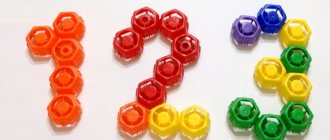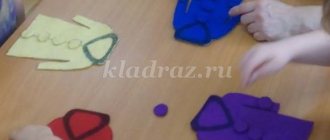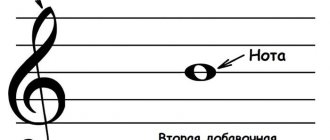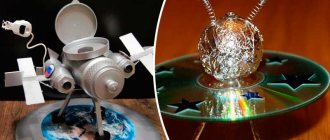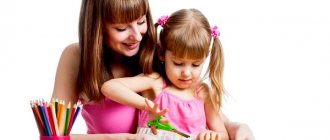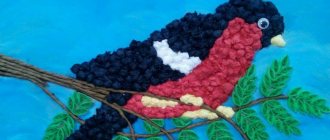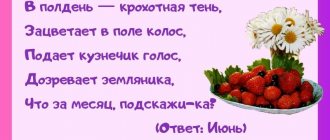Logorhythmics for children 5 years old
Logorhythmics notes for middle group preschoolers should include active games aimed at physical development and recovery. The movements become more complicated, complemented by other different actions, and the load becomes more intense. Classes should develop flexibility, promote healthy posture, and improve creativity.
Tell a friend
Logorhythmics games develop concentration and reaction speed. The players stand in pairs opposite each other. In the hand of one is a skittle, the other has a ring from a toy pyramid. When the music starts, the transfer of objects begins: one player takes the pin from the second with his right hand, and gives the ring with his left, and so on in a circle.
Cooking cabbage
Tell the poem, performing actions corresponding to the plot, and the child must repeat them:
- “We chopped the cabbage” - the baby makes chopping movements with his hands;
- “We salted the cabbage” – folds his fingers, moves them as if pouring salt;
- “We crushed the cabbage” - makes squeezing and squeezing movements with his hands;
- “We got delicious food” - claps his hands.
What rang
Show the pupils 4 objects: wooden spoons, a rattle, a glass cup, a metal bell. Ring the objects, hide them. Ring them again from the hiding place. Children must guess what is ringing.
Zoo
Divide the players into 4 groups: hares, bears, zebras, parrots. To the accompaniment of music, children move, imitating animals: “hares” jump, “bears” waddle, “zebras” raise their legs high above the floor, “parrots” wave their arms.
Geese
Logorhythmic games improve motor skills. The pupils’ task is to reproduce the actions of birds according to the rhyme:
- “The geese have arrived” - children wave their arms and run on tiptoe;
- “sat down on the lawn” - squat down;
- “walked” - players get up, slowly walk on tiptoe;
- “pecked” - they stop and bend down;
- “and quickly ran away” - the players run to their chairs and sit on them.
Rules for conducting classes in logorhythmics
Logorhythmics implies a playful form that is attractive to children. To increase your preschooler's interest in activities, use toys, illustrations, literary works, musical instruments, audio recordings, unusual objects, puppets and finger puppets.
If a child stutters, he should study every other day. With a healthy preschooler, it is enough to work twice a week.
The pace of exercises during each next lesson should gradually increase as the child successfully completes them. The musical accompaniment must correspond to the tempo of motor activity and the emotional content of the actions.
Don't show your child that you are unhappy with him. Disappointed in himself, he may refuse to do the exercises next time.
Logorhythmics for children 3 years old
3 years of age is a period of active speech development. Therefore, logorhythmics exercises for children should stimulate speech activity, improve thinking abilities, and develop articulation. We also shouldn’t forget about physical activity; outdoor games are required.
Far or near
Explain to children that far away objects make quiet sounds, while close objects make loud sounds. Offer to play animal voices. For example, a dog barks far away - the children say quietly “woof-woof”, a dog barks close - the children say loudly “woof-woof”. Likewise for cats, sheep, cows, roosters, cuckoos, frogs and other animals.
My family
Read the poem, and the students should bend their finger after each line:
- “this finger is grandpa” - kids bend their thumb;
- “this finger is grandma” - index;
- “this finger is daddy” - middle;
- “this finger is mommy” - ring finger;
- “and this finger is me” - little finger;
- “Here is my family” - the children put forward the resulting fist.
Happy tummy
The logorhythmics game is designed to improve breathing through the diaphragm. The preschooler lies on his back, relaxes, and places his favorite toy on his stomach. Ask your child to take a deep breath so that the belly rises and the toy rises with it. Then exhale so that the stomach with the toy drops. Let him repeat the action several times.
Tell me in order
Logorhythmic games develop speech breathing. The child must inhale, then, as he exhales, count the objects in the picture: one, two, three... The number of words spoken while exhaling should correspond to the age of the child.
Articulation gymnastics
Articulation exercises within the framework of logorhythmics tone the muscles of the tongue and jaws. Here are some examples:
- “I’m licking” - the mouth is not wide open, the tongue moves smoothly in a circle over the lips;
- “The teeth are hiding” - the lips are either tightly compressed, or stretched into a wide smile;
- “Football player” - the tongue moves inside the oral cavity from right to left with pressure on the mucous walls;
- “Angry tongue” - the tip of the tongue rests on the back walls of the upper pair of incisors.
Walking
To the accompaniment of music, children walk in a chain, holding the cord with their left hand. First they take the usual steps, the music conveys the appropriate rhythm. Then the pace changes, the players walk about 3 m with an extended step, raising their legs high. At the 3rd stage, children, continuing to move one after another, must step over 5 cubes and steps of a ladder placed on the floor.
Logorhythmics for children 4 years old
For a 4-year-old child, physical development and improvement of motor skills are of paramount importance. It is also important to teach preschoolers proper communication, beautiful pronunciation, and clear pronunciation of sounds.
Do like the animals
Encourage students to imitate the movements and sounds of different animals. For example, how a bear walks and growls - children answer “rrrr”, while moving in a waddle with clubfoot steps. Or, as a goose flies and screams, the players respond “ha-ha-ha”, while waving their arms widely.
I go, I swim, I fly
When children hear the word “earth,” they stomp on the floor. When they hear the word “water,” they make movements with their hands as if they are swimming. And when they hear the word “air,” they flap their arms like birds in flight.
Vegetables
Show your student illustrations of vegetables, while pronouncing their names clearly in syllables: po-mi-dor, ka-ba-chok, re-dis, ku-ku-ru-za. The child should clap his hands after each syllable he hears.
Feed the birds
To play using logorhythmics, you need to prepare grain, peas and small pebbles, as well as 6 containers. Invite the student to feed the birds that fly to the feeder. To do this, he must transfer the grain, peas and pebbles to another container. First the baby does this with one hand, then with the other, then with both. Then he uses only his fingers: the thumb with the index finger, then with the middle finger, with the ring finger and, finally, with the little finger.
Train
Preschoolers imitate train carriages: they stand one after another, bend their arms at the elbow joint, press them to their sides, and clench their palms into fists. They begin to move to the music in the appropriate rhythm, stomping their feet and at the same time making circular movements with their hands. The tempo of the music changes, following which the children change the speed of their movements.
Automobile
Children answer questions, accompanying their answers with appropriate actions:
- how the car honks - “beep, beep” - the children press their fist on the open palm of their other hand;
- how the engine makes noise - “zh-zh-zh” - they make circular movements with their hands, as if they are steering a steering wheel;
- how fast we drive - “rrrr” - loudly and quickly knocking our feet on the floor;
- how the tires rustle on the asphalt - “sh-sh-sh” - the children rub their palms against one another;
- how the wheels spin - “ta-ta-ta” - make circular movements with your arms in one direction.
For children 6 years old
From the age of 6, preschoolers are already preparing for school; logorhythmic exercises become more complex. At this age, it is important to develop rhythm, intonation, clarity of speech, the ability to express emotions, and broaden your horizons.
Living-non-living
Say the words, and the children should clap their hands when they hear the name of a living and small creature. For example: bee, telephone, pencil, mosquito, hippopotamus, giraffe, ant, grasshopper, ball, chick, button, dragonfly, window, horse, snail.
Find out the animal
Players must depict the given animals using facial expressions and body movements. For example, an important turkey, a cowardly rabbit, a slow turtle. And the rest must guess who the friend is showing.
Journey
Tell the students that they will now go traveling using different types of transport. First, in the car - the children pronounce the drawn-out sound “r-r-r”. Then on the plane - “oooh”. The plane is descending - the children pronounce the sound more quietly. The journey continues on the train - “too-too-oo-oo”. The train is moving fast - “chug-chug-chug”. Approaching the station, it slows down - the children say “chuh-chuh” more slowly. The train stopped, steam came out from under the wheels - “sh-sh-sh”. Then the journey continues on horseback - the children make a clicking sound with their tongue.
Find out by facial expressions
Children take turns naming interjections and using facial expressions to depict the corresponding emotion. The rest of us have to guess what we're talking about:
- Oh! - astonishment;
- Oh! - pain;
- Ay! – fear;
- Eh! – fun;
- Hey! - discontent;
- Oh! – confusion.
For children 7 years old
At the age of 7, preschoolers can perform complex tasks in logarithmics.
What animal is this
One player moves to the music, depicting a specific animal with body movements, facial expressions and sounds. When the music stops, it freezes. The rest must guess what animal he was depicting.
Signalman
Make 3-4 claps with your palms in different rhythms, like Morse code. And the student must repeat them in the same rhythm. For example: 3 fast, 1 slow.
Mirror
To play musical logorhythmics, prepare pictures of people in different poses. Turn on the music and let the kids dance. As soon as the melody is interrupted, the players must take the pose of the person depicted in the displayed image.
What is included in logorhythmics
Logorhythmics classes in preschool include:
- different types of physical activity - walking, squats, jumping, dancing, clapping, waving your hands - such exercises are usually used as a warm-up;
- speech correction methods;
- articulation gymnastics, breathing exercises;
- singing, reading poetry, saying tongue twisters;
- finger gymnastics;
- games to develop concentration, auditory and visual perception, memory;
- exercises to improve facial expressions, strengthen the facial and jaw muscles;
- relaxation exercises that usually end classes.
Logorhythmics by Zheleznova for children
Teacher Ekaterina Zheleznova has developed a unique logorhythmics program for preschoolers of all age groups. Classes involve simultaneous performance of speech, motor and musical exercises.
The program includes:
- movements to music;
- finger games;
- imitative tales;
- fun exercises;
- outdoor games;
- gymnastics and aerobics;
- massage games;
- staging;
- lullabies.
Zheleznova’s logorhythmics programs for different age groups were released in the form of didactic manuals, recorded on audio and video, and can be found on the Internet.
